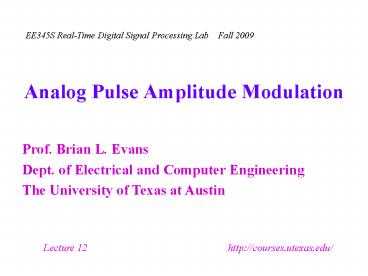Analog Pulse Amplitude Modulation PowerPoint PPT Presentation
1 / 16
Title: Analog Pulse Amplitude Modulation
1
Analog Pulse Amplitude Modulation
2
Outline
- Analog communication Systems
- Transmitter
- Channel impairments
- Receiver
- Hybrid communication systems
- Analog and digital modulation methods
- Analog pulse amplitude modulation
3
Communication Systems
Review
- Information sources
- Message signal m(t) is the information source to
be sent - Possible information sources include voice,
music, images, video, and data, which are
baseband signals - Baseband signals have power concentrated near DC
- Basic structure of an analog communication system
is shown below
4
Transmitter
Review
- Signal processing
- Conditions the message signal
- Lowpass filtering to make sure that the message
signal occupies a specific bandwidth, e.g. in AM
and FM radio, each station is assigned a slot in
the frequency domain. - In a digital communications system, we might add
redundancy to the message bit stream mn to
assist in error detection (and possibly
correction) in the receiver
5
Transmitter
Review
- Carrier circuits
- Convert baseband signal into a frequency band
appropriate for the channel - Uses analog and/or digital modulation
6
Channel
Review
- Transmission medium
- Wireline (twisted pair, coaxial, fiber optics)
- Wireless (indoor/air, outdoor/air, underwater,
space) - Propagating signals experience a gradual
degradation over distance - Boosting improves signal and reduces noise, e.g.
repeaters
7
Wireline Channel Impairments
- Linear time-invariant effects
- Attenuation dependent on channel frequency
response - Spreading finite extent of each transmitted
pulse increases, i.e. pulse widens (see next
slide) - Linear time-varying effects
- Phase jitter sinusoid at same fixed frequency
experiences different phase shifts when passing
through channel(i.e. time-varying phase
response) - Nonlinear effects
- Additive noise arises from many sources in
transmitter, channel, and receiver (e.g. thermal
noise) - Harmonics due to squaring other nonlinear
transformations (e.g. in power amplifiers)
8
Wireline Channel Impairments
- Analog transmission over communication channels
- Spreading in time domain due to convolution of
transmitted waveform channel impulse response
Tb
ThTb
Th
t
t
-A Th
-A
Model channel as LTI system with impulse response
h(t)
A
A Th
1
t
Tb
t
Th
Th
ThTb
t
Assume that Th lt Tb
9
Wireless Channel Impairments
- Same as wireline channel impairments plus others
- Fading multiplicative noise
- Talking on a mobile phone and reception fades in
and out
10
Receiver and Information Sinks
Review
- Receiver
- Carrier circuits undo effects of carrier circuits
in transmitter, e.g. demodulate from a bandpass
signal to a baseband signal - Signal processing subsystem extracts and enhances
the baseband signal - Information sinks
- Output devices, e.g. computer screens, speakers,
TV screens
11
Hybrid Communication Systems
- Mixed analog and digital signal processing in the
transmitter and receiver - Example message signal is digital but broadcast
over an analog channel (compressed speech in
digital cell phones) - Signal processing in the transmitter
- Signal processing in the receiver
Error Correcting Codes
Digital Signaling
A/D Converter
D/A Converter
m(t)
baseband signal
Decoder
Waveform Generator
Equalizer
Detection
A/D
D/A
digitalsequence
digitalsequence
code
12
Single-Carrier Modulation Methods
- Analog communication
- Transmit and receive analog waveforms
- Amplitude Modulation (AM)
- Phase Modulation (PM)
- Freq. Modulation (FM)
- Quadrature Amplitude Modulation (QAM)
- Pulse Amplitude Modulation (PAM)
- Digital communication
- Same but treat transmission and reception as
digitized - Amplitude Shift Keying (ASK)
- Phase Shift Keying (PSK)
- Freq. Shift Keying (FSK)
- QAM
- PAM
13
Pulse Amplitude Modulation (PAM)
- Amplitude of periodic pulse train is varied with
a sampled message signal m - Digital PAM coded pulses of the sampled and
quantized message signal are transmitted
(lectures 12 and 13) - Analog PAM periodic pulse train with period Ts
is the carrier (below)
m(t)
s(t) p(t) m(t)
14
Analog PAM
- Pulse amplitude varied with amplitude of sampled
message - Sample message every Ts
- Hold sample for T seconds (T lt Ts)
- Bandwidth ? 1/T
- Transmitted signal
- h(t) is a rectangular pulseof duration T units
sample
hold
15
Analog PAM
- Transmitted signal
- Fourier transform
- Equalization of sample and hold distortion added
in transmitter - H(f) causes amplitude distortion and delay of T/2
- Equalize amplitude distortion by post-filtering
with magnitude response - Negligible distortion(less than 0.5) if
msampled(t)
16
Analog PAM
- Requires transmitted pulses to
- Not be significantly corrupted in amplitude
- Experience roughly uniform delay
- Useful in time-division multiplexing
- public switched telephone network T1 (E1) line
time-division multiplexes 24 (32) voice channels - Bit rate of 1.544 (2.048) Mbps for duty cycle lt
10 - Other analog pulse modulation methods
- Pulse-duration modulation (PDM),a.k.a. pulse
width modulation (PWM) - Pulse-position modulation (PPM) usedin some
optical pulse modulation systems.

